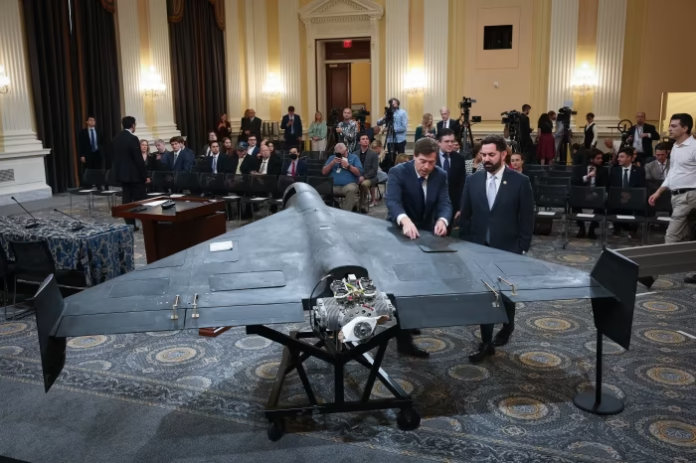The United States and its Western partners are accelerating efforts to build weapons modeled after Iran’s Shahed drones, highlighting a new phase in modern warfare where low-cost, long-range munitions are reshaping battlefield strategies.
Russia’s Escalating Drone Warfare
Russia’s heavy reliance on Iranian-designed drones in Ukraine has become a turning point. According to Ukrainian military reports, Moscow has already launched more than 33,000 Shahed-type drones in 2025, a staggering sevenfold increase compared to 4,800 strikes during the same period last year.
This dramatic surge has forced Washington and its allies to respond quickly. The Pentagon recently established new task forces dedicated to fast-tracking U.S.-made alternatives.
Defense Secretary Pete Hegseth announced earlier this week that U.S. Central Command has formed a specialized unit tasked with delivering “combat-credible” drone systems to American forces in the Middle East within just 60 days. The initiative is part of Hegseth’s broader plan to ensure that by the end of 2026, every U.S. military squad will be equipped with expendable drones—beginning with priority units in the Indo-Pacific region.
Pentagon Tests Drone Prototypes

American defense companies are already unveiling systems inspired by the Shahed. At a Defense Department demonstration this summer, 18 drone prototypes were showcased, many closely resembling Iran’s design. Notable examples include the “LUCAS” drone by SpectreWorks and Griffon Aerospace’s “Arrowhead” long-range attack drone.
The U.S. Air Force has gone a step further by requesting 16 exact replica Shahed-136 drones from private contractors. The solicitation specifically demands a one-to-one copy in terms of design, performance, and functionality. These replicas will be used to test and develop advanced counter-drone defenses.
Griffon Aerospace’s MQM-172 Arrowhead, unveiled in August, demonstrates how the West is adapting. Unlike Iran’s single-use drone, the Arrowhead can serve as both a training target and a strike weapon. It features a delta-wing design, supports payloads of up to 100 pounds, and can be launched using various methods, including pneumatic systems or rocket-assisted takeoff.
European defense industries are also getting involved. Sweden’s Saab has begun producing practice drones that mirror the Shahed design, enabling allied militaries to train against similar aerial threats.
The Cost Gap: A Critical Challenge

While Western prototypes are advancing rapidly, cost remains the biggest obstacle. According to Ukrainian intelligence, Russia produces Shahed-type drones at its Alabuga Special Economic Zone for about $70,000 per unit. Earlier assessments suggested costs could be as low as $35,000.
In stark contrast, Western systems are far more expensive. U.S. defense firm Anduril Industries recently sold 291 of its Altius long-range drones to Taiwan at a price of more than $1 million each, including training and infrastructure.
Former President Donald Trump underscored this cost disparity earlier this year, noting that Iran spends between $35,000 and $40,000 per drone, while American companies have quoted prices as high as $41 million for similar platforms.
Western manufacturers argue their systems justify the higher price tag through superior technology and performance. For instance, Britain’s MGI Engineering promotes its “Skyshark” drone as significantly faster, reaching speeds of 280 miles per hour, compared to the Shahed-136’s modest 115 mph.
Strategic Consequences for Global Security
Russia’s expanded use of mass-produced drones marks a major shift in global military strategy. At the beginning of the Ukraine conflict, Moscow deployed roughly 150–200 Shahed drones per month. Today, the figure is closer to 5,000 monthly launches, underscoring the scale of production.
On September 7, Russia carried out its largest aerial strike to date, using 860 drones and missiles in one night. Some of these drones even crossed into NATO territory in Poland, raising alarms across Europe.
Experts warn that this evolution has changed the nature of modern conflict. “Russia’s mass deployment of low-cost drones to overwhelm Ukraine’s defenses has been a game changer,” said James Patton Rogers, a drone warfare analyst at Cornell University’s Brooks Institute for Tech Policy. “The rise of affordable, precision-guided saturation strikes now represents one of the greatest threats to international security.”
The Future of Drone Warfare
The contest between Western defense industries and adversaries like Iran and Russia is no longer just about technology. The real challenge lies in scaling production and lowering costs to keep pace with asymmetric strategies that prioritize numbers over sophistication.
Unless the U.S. and its allies find a way to balance affordability with capability, experts warn that adversaries relying on low-cost, mass-produced drones may maintain a decisive edge in future conflicts.
For now, the global arms race around Shahed-inspired systems signals a pivotal moment in warfare—where drones costing tens of thousands of dollars can disrupt militaries that spend millions on traditional platforms.

